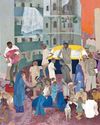
Where was Mahatma Gandhi on 15 August 1947? Surely the man who had led the movement for freedom would be in the forefront of the national celebrations in Delhi on that day. Instead, Gandhiji created one of the most extraordinary happenings in his eventful life. Here is the story:
BIHAR AND EAST
Bengal had suffered severely from violent communal strife in late 1946. In the Noakhali district of East Bengal, members of the Muslim majority had attacked their Hindu neighbors and burnt their houses. Gandhi immediately went there to bring the two communities together again. Soon the Muslim minority in Bihar was even more brutally attacked by their Hindu neighbors. Gandhi went there to give courage to the Muslims and a change of heart to the Hindus. I joined Gandhiji in Bihar, and together we traveled to Calcutta. On 11 August we would go to East Bengal, for Gandhi had given a solemn pledge to the frightened Noakhali Hindus that on Independence Day, when East Bengal would become part of Pakistan, he would be with them.
Hours after our arrival in Calcutta, leading Muslims from Calcutta had visited Gandhiji and had begged him not to go to East Bengal. He must stay in Calcutta, and try to bring peace to the great city. If there was peace in Calcutta, they said, there would be peace throughout all of Bengal. Gandhiji was not easily convinced. He wanted full assurance that the Muslim bosses in East Bengal would protect the Naokhali Hindus. Time was short; but the Muslim leaders agreed, so Gandhiji stayed in Calcutta.
GANDHIJI HAD A PLAN.
Denne historien er fra March 2020-utgaven av Reader's Digest India.
Start din 7-dagers gratis prøveperiode på Magzter GOLD for å få tilgang til tusenvis av utvalgte premiumhistorier og 9000+ magasiner og aviser.
Allerede abonnent ? Logg på
Denne historien er fra March 2020-utgaven av Reader's Digest India.
Start din 7-dagers gratis prøveperiode på Magzter GOLD for å få tilgang til tusenvis av utvalgte premiumhistorier og 9000+ magasiner og aviser.
Allerede abonnent? Logg på

BOOKS
Books review

STUDIO - Off Lamington Road by Gieve Patel
Oil on Canvas, 54 x 88 in

NEWS FROM THE WORLD OF MEDICINE
FOODS THAT FIGHT DEMENTIA

TO HELL AND BACK
The Darvaza crater in Turkmenistan is known as the Gates of Hell. I stood on its edge - and lived to tell the tale

THE SNAKE CHARMERS
Invasive Burmese pythons are squeezing the life out of Florida's vast Everglades. An unlikely sisterhood is taking them on

Sisterhood to Last a Lifetime
These college pals teach a master class in how to maintain a friendship for 50-plus years

...TO DIE ON A HOCKEY RINK
ONE MINUTE I WAS PLAYING IN MY BEER LEAGUE, THE NEXT I WAS IN THE HOSPITAL

Just Sit Tight
Broken, battered and trapped in a ravine for days, I desperate driver wonders, \"Will anyone find me?\"

Allow Me to Mansplain...
If there's one thing we know, it's this: We're a nation of know-it-alls

THE BITTER TRUTH ABOUT SUGAR (AND SUGAR SUBSTITUTES!)
It's no secret that we have a serious addiction. Here's how to cut back on the sweet stuff, once and for all.